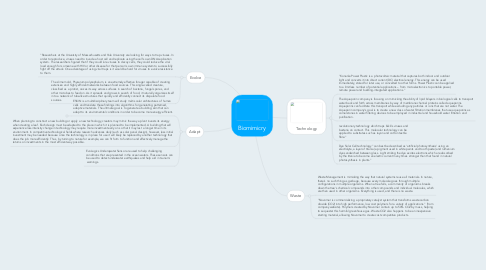Biomimicry
by Mary May Schuessler

1. Evolve
1.1. "Researchers at the University of Massachusetts and Yale University are looking for ways to trap viruses. In order to reproduce, viruses need to invade a host cell and replicate using the cell's own DNA-replication system. The researchers figured that if they could lure viruses to decoy cells, they could reduce the viral load enough for someone with HIV or other disease for that person's own immune system to successfully fight off the attack. One advantage of using viral traps is it would be hard for viruses to evolve resistance to them.
1.2. The slime mold, Physarum polycephalum, is an extremely effective forager capable of creating extensive and highly efficient networks between food sources. This single-celled creature, classified as a protist, oozes its way across surfaces in search of bacteria, fungal spores, and other microbes to feed on. As it spreads and grows in search of food, it naturally organizes itself into a network of tube-like structures that quickly and efficiently connect its disparate food sources.
2. Adapt
2.1. ESKIN is a multidisciplinary team will study multi scalar architectures of human cells and translate these findings into algorithms for generating patterned, adaptive materials. The ultimate goal is to generate a building skin that can adapt to its enviromemtal conditions in order to become more energy efficient.
2.1.1. When planning to construct a new building or apply a new technology, creators may mimic the way a plant invests its energy when creating a leaf. Each design must be adapted to the place in which it is planned to be implemented. A building that will experience low-intensity change in technology may require more investment early on so that it may last a longer time in its environment. In competitive technological fields where research advances daily (such as solar panal design), however, less initial investment may be needed because once the technology is in place for use it will likely be replaced by another technology that does the job more efficiently. Thus, by turning to nature for example, we can fit form to function and effectively manage the returns on investments in the most efficient way possible.
2.2. When planning to construct a new building or apply a new technology, creators may mimic the way a plant invests its energy when creating a leaf. Each design must be adapted to the place in which it is planned to be implemented. A building that will experience low-intensity change in technology may require more investment early on so that it may last a longer time in its environment. In competitive technological fields where research advances daily (such as solar panal design), however, less initial investment may be needed because once the technology is in place for use it will likely be replaced by another technology that does the job more efficiently. Thus, by turning to nature for example, we can fit form to function and effectively manage the returns on investments in the most efficient way possible.
2.3. EvoLogics Underqwater Sensor are used to help challenging conditions that are presented in the ocean waters. These sensors can be used to detect underwater earthquakes and help aid in tsunami warnings.
3. Technology
3.1. "Konarka Power Plastic is a photovoltaic material that captures both indoor and outdoor light and converts it into direct current (DC) electrical energy. This energy can be used immediately, stored for later use, or converted to other forms. Power Plastic can be applied to a limitless number of potential applications – from microelectronics to portable power, remote power and building-integrated applications."
3.2. The Aquaporin company is focusing on mimicking the ability of lipid bilayers in biological cells to transport water back and forth across membranes by way of membrane channel proteins called aquaporins. Aquaporins can facilitate this transport while excluding any particles or ions that are not water. The Aquaporin company's goal is to create a new class of water filtration membranes that use aquaporins as cornerstones in water filtering devices to be employed in industrial and household water filtration and purification.
3.3. revolutionary technology which traps & kills viruses and bacteria on contact. This molecular technology can be applied to substrates such as rayon and cotton textile fibre."
3.4. Dye Solar Cell technology "can best be described as ‘artificial photosynthesis’ using an electrolyte, a layer of titania (a pigment used in white paints and tooth paste) and ruthenium dye sandwiched between glass. Light striking the dye excites electrons which are absorbed by the titania to become an electric current many times stronger than that found in natural photosynthesis in plants."
4. Waste
4.1. Waste Management is mimicking the way that natural systems reuse all materials. In nature, there's no such thing as garbage, because every molecule goes through multiple configurations in multiple organisms. When a tree falls, a community of organisms breaks down the tree's chemical compounds into other compounds and individual molecules, which are then used in other organisms. Everything is used, and there is no waste.
4.2. "Novomer is commercializing a proprietary catalyst system that transforms waste carbon dioxide (CO2) into high performance, low cost polymers for a variety of applications." (from company website). Polymers created by Novomer contain up to 50% CO2 by mass, helping to sequester this harmful greenhouse gas. Waste CO2 also happens to be an inexpensive starting material, allowing Novomer to create cost-competitive products.


